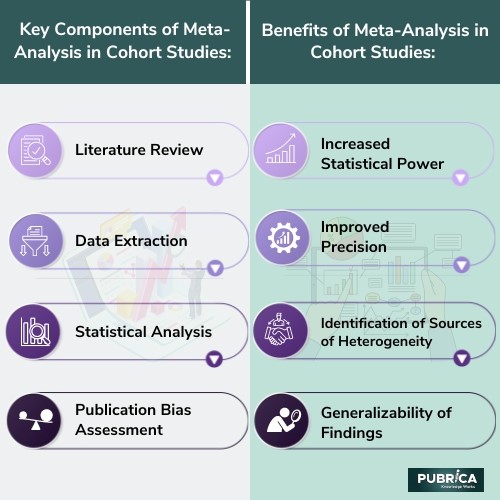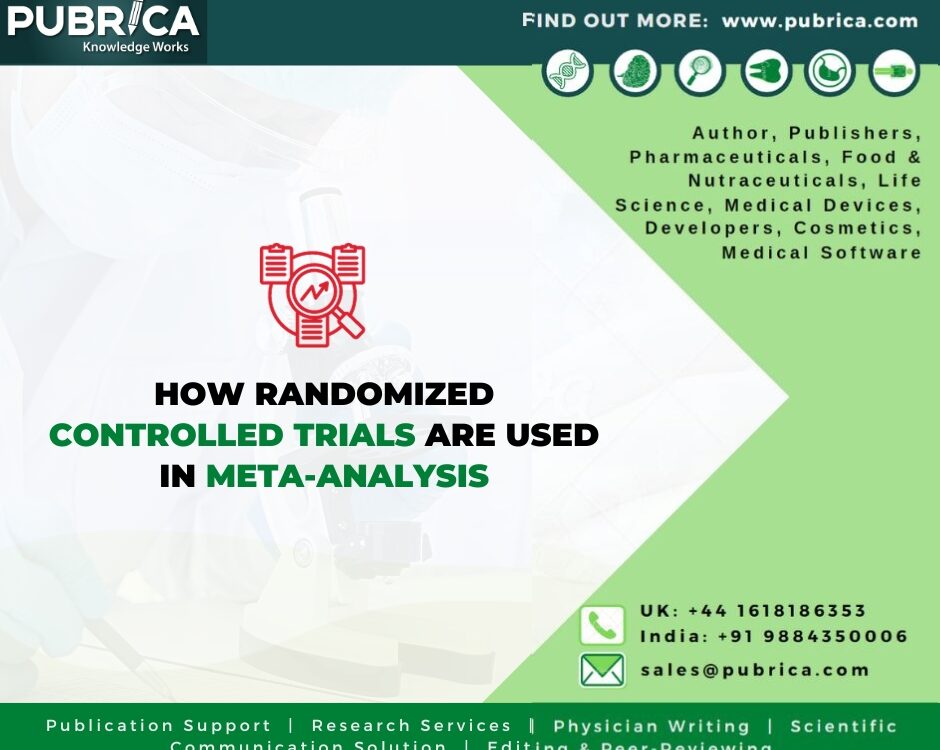
What are the differences in publishing diabetes epidemiological manuscripts?
December 2, 2023
From Lab to Literature: Exploring the Roadblocks Physicians Navigate in Publishing Their Research
January 18, 2024In brief
Cohort studies play a pivotal role in the realm of scientific research, providing valuable insights into the association between exposure and outcomes over time. However, to truly understand the bigger picture and draw more robust conclusions, researchers often turn to a powerful tool known as meta-analysis. In this blog post, we’ll delve into the intricate relationship between meta-analysis and cohort studies, exploring how this combination enhances the depth and reliability of research findings.
- To know more about meta-analysis services, check our study guide on what is epidemiological study design in meta-analysis research?
Introduction:
Cohort study
Cohort studies analyze a population over time. Researchers can investigate the incidence of various outcomes. In an etiological study, the risk of a result is compared between an exposed and an unexposed group. It is possible to investigate different degrees of exposure as well as exposures that change over time. Cohort studies include instrumental variable approaches and self-controlled case series research.
Example: The incidence of infectious complications was examined between individuals with and without Cushing illness in a large population-based cohort study.
Mendelian randomization/instrumental variable approaches
Instrumental variable (IV) studies employ an external factor that influences the exposure of interest but is (ideally) unrelated to the result other than through its effect on the exposure. In other words, the instrument is unrelated to the factors that might confuse the relationship between exposure and outcome. Calendar time, geographical location, or treatment preferences can all be used as instruments. Mendelian randomization studies are instances of IV analyses that use genetic variables as tools.
Meta-analysis is a statistical technique used to combine and analyze the results from multiple independent studies on a specific research question or topic. It is commonly employed in medical and social sciences to provide a more comprehensive meta-analysis and reliable summary of evidence.
Understanding Cohort Studies:
Before delving into meta-analysis, let’s briefly revisit the essence of cohort studies. A cohort study involves tracking a group of individuals over time, observing and collecting data on their exposure to certain factors and subsequent outcomes. This longitudinal approach allows researchers to establish associations and identify potential causal relationships between variables.
The Need for Meta-Analysis:
While cohort studies offer valuable insights, they are not without limitations. Variations in study design, sample size, and methodology can lead to inconsistencies in findings. Meta-analysis steps in to address these challenges by systematically reviewing and combining data from multiple studies, providing a meta-analysis for qualitative research of results.

Key Components of Meta-Analysis in Cohort Studies:
- Literature Review: Meta-analysis begins with a comprehensive literature review. Researchers identify relevant cohort studies, considering factors such as study design, participant characteristics, and outcome measures.
- Data Extraction: Systematic extraction of data from selected studies is a critical step. This involves collecting information on study populations, exposure variables, outcomes, and statistical measures of association.
- Statistical Analysis: Advanced statistical techniques are employed to combine the data from individual studies. Effect sizes, confidence intervals, and heterogeneity measures are calculated to assess the overall impact and consistency of findings across studies.
- Publication Bias Assessment: Meta-analysis also addresses publication bias, a phenomenon where studies with statistically significant results are more likely to be published. This step involves evaluating the potential impact of unpublished or overlooked studies on the overall findings.
Benefits of Meta-Analysis in Cohort Studies:
- Increased Statistical Power: By combining data from multiple studies, meta-analysis enhances statistical power, enabling researchers to detect smaller but potentially significant effects.
- Improved Precision: Meta-analysis provides more precise estimates of the true effect size by pooling data from diverse sources. This helps in refining conclusions and making evidence-based recommendations.
- Identification of Sources of Heterogeneity: Analyzing heterogeneity among studies allows researchers to identify sources of variation and explore potential subgroups where the association between exposure and outcome may differ.
- Generalizability of Findings: Meta-analysis contributes to the generalizability of results, as it considers a broader range of populations and settings, making findings more applicable to different contexts.
Conclusion:
In conclusion, meta-analysis acts as a powerful magnifying glass, amplifying the impact and reliability of cohort studies. By synthesizing data collection from various sources, researchers can overcome the limitations of individual studies, providing a more comprehensive and nuanced understanding of complex relationships. This dynamic interplay between cohort studies and meta-analysis not only strengthens the foundations of scientific knowledge but also paves the way for more informed decision-making in various fields of research and therapeutics
-
✔
Check our Examples to get an understanding of our adaptability across meta-analysis topics and subject domains.
About Pubrica
Pubrica’s team of researchers and authors develop scientific and medical research papers that can act as indispensable tools for practitioners/authors across all Medical Industries. meta-analysis experts will undertake a thorough examination of your research topic, a systematic review, data extraction, standardization and weighting studies, and ultimately choose and apply an appropriate model to compare effect sizes across different studies. All tasks must be completed in accordance with PRISMA rules and other reporting criteria.
References
- Niebuur, Jacobien, et al. “Determinants of participation in voluntary work: a systematic review and meta-analysis of longitudinal cohort studies.” BMC Public Health 18 (2018): 1-30.
- Batty, G. David, et al. “Comparison of risk factor associations in UK Biobank against the representative, general population-based studies with conventional response rates: prospective cohort study and individual participant meta-analysis.” bmj 368 (2020).



